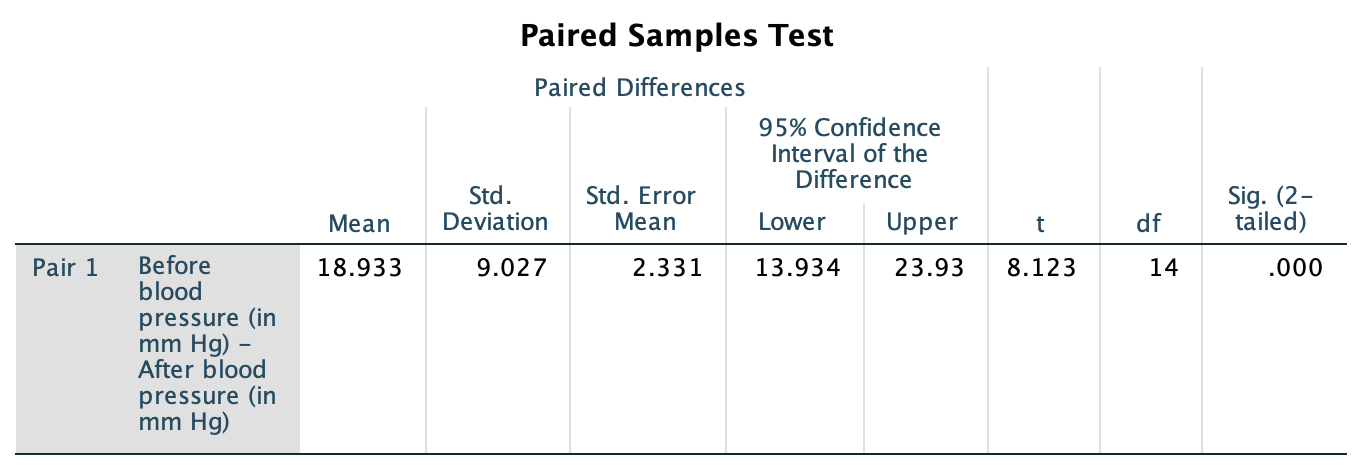29.11 Exercises
Selected answers are available in Sect. D.27.
Exercise 29.1 People often struggle to eat the recommended intake of vegetables. In one study exploring ways to increase vegetable intake in teens (Fritts et al. 2018), teens rated the taste of raw broccoli, and raw broccoli served with a specially-made dip. (These data were also seen in Exercise 23.1.)
Each teen () had a pair of measurements: the taste rating of the broccoli with and without dip. Taste was assessed using a ‘100 mm visual analog scale,’ where a higher score means a better taste. In summary:
- For raw broccoli, the mean taste rating was (with a standard deviation of );
- For raw broccoli served with dip, the mean taste rating was (with a standard deviation of ).
Because the data are paired, the differences are the best way to describe the data. The mean difference in the ratings was , with standard error of .
Perform a hypothesis test to see if the use of dip increases the mean taste rating.Exercise 29.2 In a study of hypertension (Hand et al. 1996; MacGregor et al. 1979), patients were given a drug (Captopril) and their systolic blood pressure measured immediately before and two hours after being given the drug (data shown). The aim is to see if there is evidence of a reduction in blood pressure after taking Captopril. (This study was also seen in Exercise 23.2.)
Using these data and the software output (jamovi: Fig. 29.8; SPSS: Fig. 29.9):
- Explain why it is probably more sensible to compute differences as the Before minus the After measurements. What do the differences mean when computed this way?
- Compute the differences.
- Construct a suitable graph for the differences.
- Write down the hypotheses.
- Write down the -score.
- Write down the -value.
- Write a conclusion.
| Before | After | Before | After |
|---|---|---|---|
| 210 | 201 | 173 | 147 |
| 169 | 165 | 146 | 136 |
| 187 | 166 | 174 | 151 |
| 160 | 157 | 201 | 168 |
| 167 | 147 | 198 | 179 |
| 176 | 145 | 148 | 129 |
| 185 | 168 | 154 | 131 |
| 206 | 180 | NA | NA |

FIGURE 29.8: jamovi output for the Captoril data

FIGURE 29.9: SPSS output for the Captoril data
Exercise 29.3 A study (A. M. Allen et al. 2018) examined the effect of exercise on smoking. Men and women were assessed on a range of measures, including the ‘intention to smoke.’ (This study was also seen in Exercise 23.3.) ‘Intention to smoke,’ and other measures, were assessed both before and after exercise for each subject, using the 10-item quantitative Questionnaire of Smoking Urges – Brief scale (Cox, Tiffany, and Christen 2001), and the quantitative Minnesota Nicotine Withdrawal Scale (Shiffman, West, and Gilbert 2004).
Smokers (defined as people smoking at least five cigarettes per day) aged 18 to 40 were enrolled for the study. For the 23 women in the study, the mean intention to smoke after exercise reduced by 0.66 (with a standard error of 0.37). Perform a hypothesis test to determine if there is evidence of a population mean reduction in intention to smoke for women after exercising.Exercise 29.4 In a study (Cressie, Sheffield, and Whitford 1984) conducted at the Adelaide Children’s Hospital:
…a group of beta thalassemia patients […] were treated by a continuous infusion of desferrioxamine, in order to reduce their ferritin content…
— Cressie, Sheffield, and Whitford (1984), p. 107; emphasis added
Using the data (shown below), conduct a hypothesis test to determine if there is evidence that the treatment reduces the ferritin content, as intended.